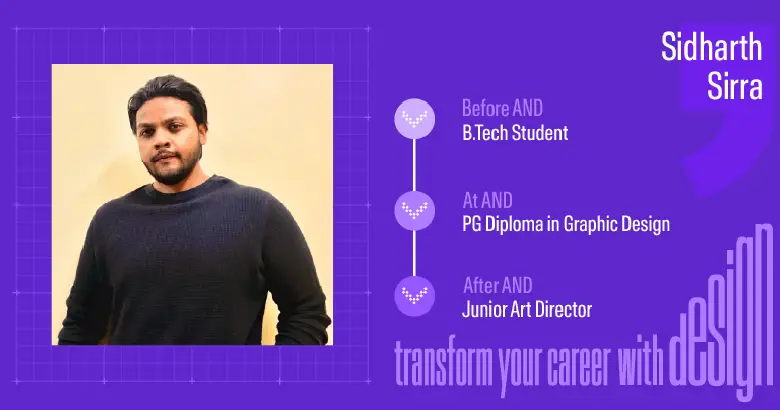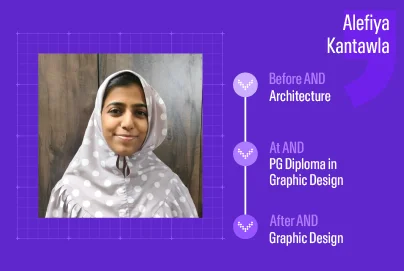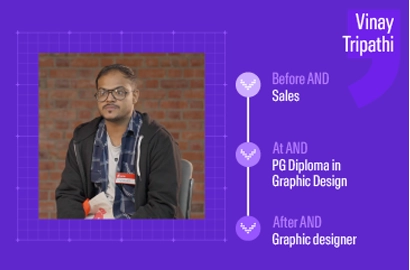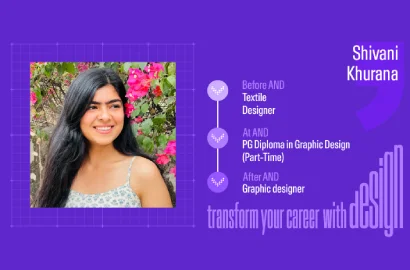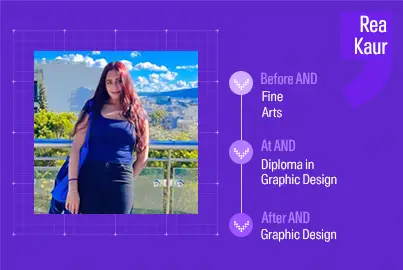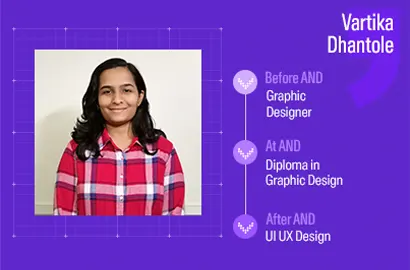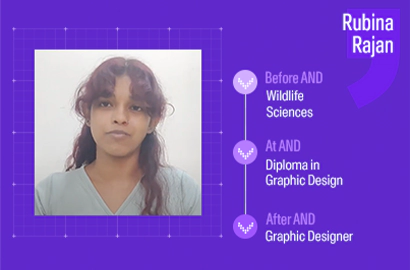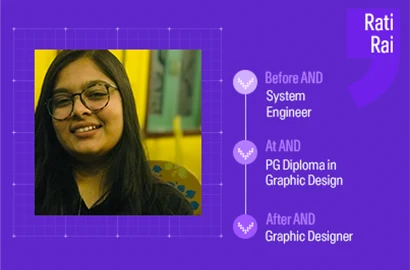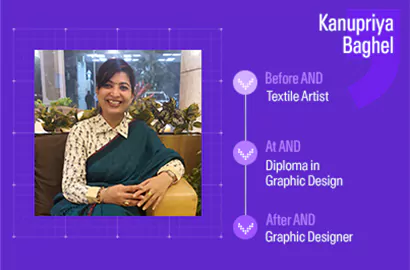In the latest edition of Student Journey, we discuss with Sidharth Sirra his journey of learning graphic design at AND Academy. Read on to learn about his experience and how it continues to shape his career as a designer!
“The structured approach at AND Academy allows you to understand the design process and the perspective needed to create effective designs.”
In our conversation with AND Alumni, Sidharth Sirra, we explored his experience pursuing a PG Diploma in Graphic Design (full-time). He shares his experience of switching from engineering to graphic design and how AND Academy changed his perspective on the design space.
So, let’s dive right in! Here’s a brief overview of all that we have covered.
- Sidharth’s background and hobbies
- How he discovered his interest in graphic design
- What made him join AND Academy
- Sidharth’s type-based poster project
- Sidharth’s brochure project
- His major challenges and learnings course at AND?
- Top three aspects of AND that had the most impact on him
- His current career aspirations
- His advice to future learners
- Would he refer AND Academy to his peers
1. Let’s begin with you telling us a little bit about yourself! Would you like to share your background, interests, and hobbies other than design with us?
Hi, I’m Sidharth Sirra and my background is in engineering. Design wasn’t something I initially set out to do; it kind of just came up during my engineering years. That was my first introduction to design and how I got interested.
Before that, I was the type of kid who was curious about everything, always wanting to figure out how things work. You know, the type where if you were given a toy, you’d break it down, go into the motor, and see how it functions? I was that type of kid.
As I grew up, I became even more enthusiastic about understanding how everything works. Alongside that curiosity, I explored personal interests like bodybuilding and martial arts – those were my main physical activities. Then, all of a sudden, I got really into listening to music and became fascinated with how music is made. I started figuring it out, producing music on my computer, and making beats.
That was during the Covid years. While doing that, I naturally became part of online communities where people needed album art for their music. That’s when I started learning how album art is designed, and from there, I jumped into the design field, and things kind of exploded.
That’s a very varied set of interests!
2. What led you to shift from a technical field to a creative field like graphic design?
My time in engineering definitely played a role. I was an electronic communication student, and during one of the assignments, we were supposed to build neurotechnologies based on chip programming and then pitch them. This involved not just coming up with the solution but also creating official branding for it. That’s when I realized design isn’t just about the product itself; it’s much something more than that. It brought me to an understanding of what design truly is and everything it encompasses.
Initially, my mindset about design was purely functional – based on how it provided a solution. I was just designing stuff on the computer, picking up elements, putting them on a canvas, and trying to make it look good, but without really knowing the deeper ‘what’ or ‘why’. I knew how to make things look good, but didn’t understand what I was communicating. That curiosity led me to graphic design.
Your curiosity is definitely an asset to you!
3. What made you join AND Academy’s Graphic Design course?
After discovering my interest in the field, I was looking for courses. I remember I discovered AND Academy through Instagram. I quickly scanned through the page and did my research. What struck me was that they offered a one-year course. I inquired, got the details, and then decided to join.
AND Academy teaches more than just surface-level aesthetics. Looking at their Instagram page now, I see it’s a great branding strategy – every post is in sync; there’s an overlay and a pattern. It feels like a brand, not just an institute, which differentiates it from most others. That structured, in-depth approach their social media takes definitely motivated me to join.
We are glad to have you at AND Academy!
4. Now, let’s discuss your type-based poster project that we have heard great things about! Would you like to take us through it?
Sure. So, for the type-based poster, we were given a choice to pick our favorite artists and work with their art. This was great because it built familiarity, and we understood the context well. As a part of the brief, we were also given a specific word and typeface to use.
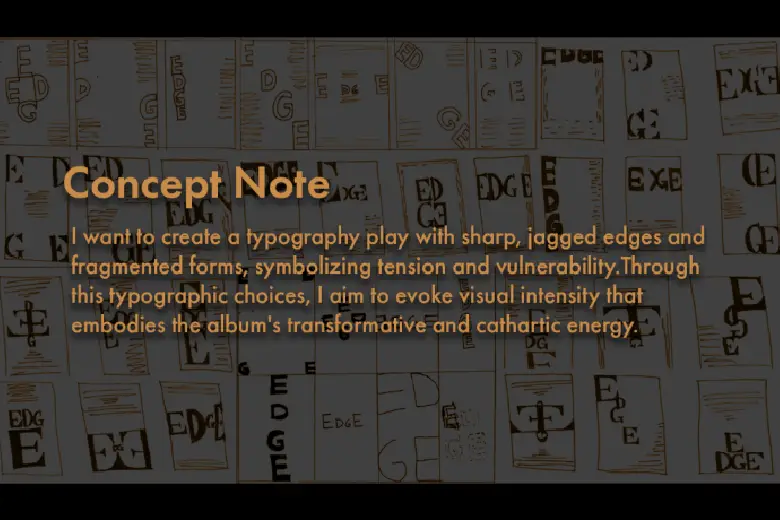
Concept note for the project
I picked the word “edge” to represent hip-hop culture, and the artist I chose was Kanye West. In my opinion, he is one of the greatest artists ever, and his work provided a rich context to explore the concept of “edge.” My initial approach was to dive into visual inspirations related to him and the chosen word. I went and picked all my favorite scenes and visuals from a particular album – his latest release at the time, “Vultures.” The idea was to build a mood board based on these visual inspirations.
So, building the mood board was the first step after picking the artist and concept. I researched these amazing visuals associated with the album rollout – some were official, and some were fan-made. I looked at them and thought, “This looks so good,” but I didn’t know why they were used or how they communicated with the audience. I just knew they were good and really matched the vibe of the album and the concept of “edge.”
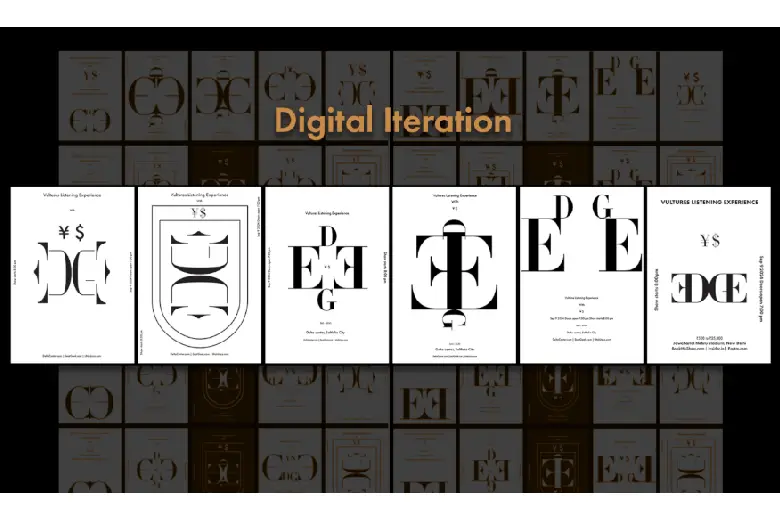
Digital Iterations
What stood out was the contrast. The official artwork was quite simple and plain. It showed simplicity, yet complexity without giving away the album’s idea. However, the fan-made designs often showed more of the album’s narrative, the character – Kanye himself – and his journey through it. I could see his journey reflected in the color combinations, the lines, the overlaid textures. It became my focus to represent his journey through the visual elements.
Then came the idea generation bit. Brainstorming was a step that was particularly new for me in this structured way. I didn’t know we had to come up with ideas first on paper, then build a solid background concept, and eventually digitize them. So, I started sketching, and putting ideas down. We digitized those initial sketches and then did a few final tweaks. After that, we applied colors and took printouts to see how it worked physically.
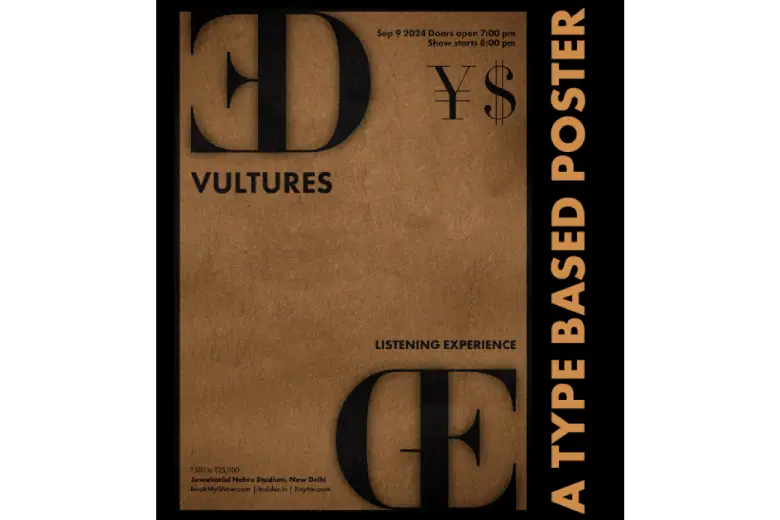
Sidharth’s type-based project
There were challenges, of course. Readability became an issue with some iterations. But the good thing is, that mentors encouraged us to go back and change things. So, I kept iterating and realized my initial final concept wasn’t quite working; although it was readable, it wasn’t giving the right vibe. It wasn’t capturing the journey the way I wanted. So, I broke it down into phases and this eventually led to the final poster. It’s a process, and even though I made my peace with the final version, I knew there were still little things to clean up.
That’s a great project!
5. There’s another brochure project you did that also caught our attention. So, how about we discuss a little about the project and your experience working on it?
Yeah, we did a brochure project as well. The crucial first step was picking a topic, and the theme was Indian art forms. I picked leather puppetry, which is an art form very close to my the state I come from- Andhra Pradesh- and it’s also practiced extensively in areas around us.
So, the process started with building a mood board. I started by gathering all the information about the materials used, and the process of puppet creation by the craftsmen, and then did some quick research on how it works and the steps involved. The whole process involved a lot of background research. This kind of extensive research may not seem important at first glance but a designer knows how crucial it is. A simple Google search is not enough, for a good design you ought to know the context, and without proper, extensive research, there’s no context. The research helps create an experience not just a visual design. It shows that leather puppetry is a real art form, not just some good-looking figures put together.

Research for the brochure project
Anyway, moving to the project, the key part of this module for me was the Design Inception Sheet. That blew me away! It’s the best part of the research process. It helps you put all the pieces together and make sense of it. The initial research tells you what is happening, how it’s happening, for whom, and where. And then you build the “vibe” using the design inception sheet. It defines the mood, the visual language, the tone, etc, and guides the entire design. For the brochure, the middle circle of the inception sheet represents the core ‘why’, and the outer circle dictates what the elements would look like.
From there, I developed layouts. It is all about how the brochure will finally look and fold – exploring different folding techniques and other aspects. You see what size works, and what doesn’t, put different elements together, and build on it.
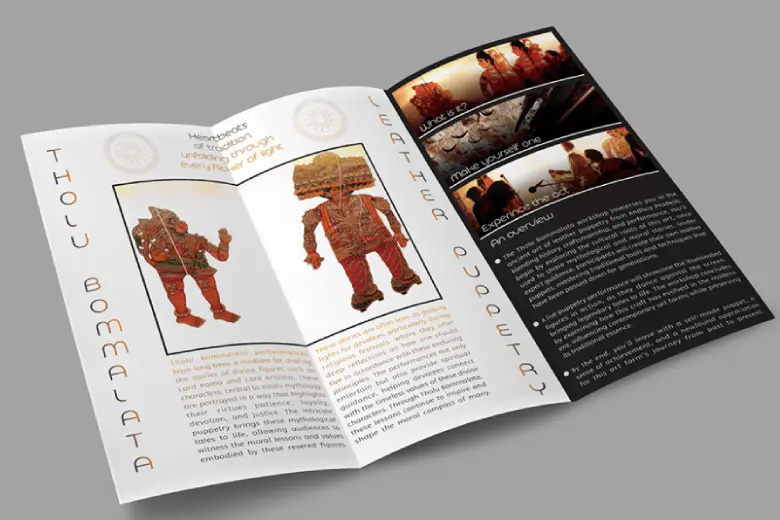
The final brochure design with three folds
After the first design was complete, I came up with fixes and refinements based on the vibe I wanted to build on and decided on elements like font style, white space, etc. This led to the final iteration, the final brochure that I made. The research part is very essential for designing anything. And it is quite evident in this project because as you fold and unfold, the story unfolds too, with the figure exploring the scene!
The research work you put in really commendable!
6. Would you like to share the major challenges and learnings you gained from working on this project and pursuing this course at AND?
The real challenge was understanding that design isn’t just about making things look good. It’s about making sure that the message is communicated effectively. If that doesn’t work, the whole design, even if it looks good, isn’t actually working. That was a real challenge – shifting my focus from just aesthetics to communication. Like I said before, I knew how to make things look good, but I didn’t always know what the design was truly talking about. The visual communication part is the real deal. So, I went through a lot of iterations in both projects, working on how to communicate my initial thoughts more effectively.
The learning outcomes were quite a few and very important for me as a designer. From the type-based poster, the learning outcome was understanding the character and personality of the subject and communicating it well. I learned how to define the target audience and how to design for them.
From the brochure project, and the overall journey, the main takeaway is the importance of research and putting all the pieces together. Learning about Design Inception Sheets and contextual research was a huge breakthrough for me. It really helped me understand that design is more than a surface-level thing. The course really makes you think beyond the visual appeal of the design.
Glad you learned so many valuable lessons here!
7. What are the top three aspects of AND Academy that had the most impact on you?
Firstly, the workshop sessions were great. They take you out of the regular course structure and make you do something different. You learn a lot of new techniques. For example, we had image reading sessions where we started thinking like a photographer, and analyzing design elements. That had a great impact on me, seeing how design elements are truly in everything.
Then they introduced visual communication workshops, which were very new and out-of-the-box. They helped me think differently and encouraged me to explore new techniques and generate new ideas.
Secondly, the mentors are really good. They actually care about you and work with you. They don’t just teach and go. They take the pain to answer every question. Even after hours, you can tag them on your board and they will respond with a solution to your problems. You get to sit with them and work on your projects. For an online course, that is truly really great.
Thirdly, the overall structure and support. I think I was well-supported throughout. I never felt any difficulty because everything moved so smoothly. I was enjoying the learning process because it was all about exploring different stuff. Like I said, I’m the type who gets into things and wants to know how they work. For me, the well-planned structure of the modules made me feel comfortable with my curiosity about new things.
The course didn’t make me question why I was there. It felt like, “Yeah, this is something I like, and I want to do this.” There wasn’t any real gap between the online and offline experience, except maybe physically sitting together. The interactions within the class and with the mentors were excellent. We were open from the beginning, raised our hands, talked, and all queries were answered well.
It is really great that AND could make such an impact on you!

8. What are your current career aspirations like?
Initially, my goal was to become a graphic designer – maybe design some good posters, good logos, that sort of thing. But now, having gone through the course and learned so much, I want to become someone significant, like a Brand Identity Designer, or maybe a Creative Director. In fact, I recently landed a job as a Junior Art Director and I am really excited to learn and explore new things!
I feel each stage of learning revealed a bigger version of the graphic designer I could be. So I aim for that as I go forward.
That is great to know, Sidharth! Many congratulations and all the best for your new role!
9. If you could give advice to someone who is on a similar journey as yours, what would that be?
I would say that when you want to join something like this, don’t just think about what you’re going to do after the course or what you’ll get out of it. Instead, think about what the course is offering you right now and how it is developing you.
If you’re seriously thinking about any course, thoroughly look into that specific course and what it teaches. It’s not just about any online course you can find – graphic design courses are everywhere, even on YouTube. That isn’t a big deal. The real deal is when you get to know how it’s done, why it’s done, and for whom it’s done. These are the main things you get to learn in well-structured modules. That’s the differentiator among online courses.
Especially if you’re coming from an engineering background, you must know that you have this whole process before building something. You’ll know why you’re doing what you’re doing because everything is often done manually or with a clear structure first. This structured approach, understanding the process and the perspective behind the design, is what AND Academy helps you learn.
That’s great advice!
10. Lastly, would you refer AND Academy courses to your peers?
Definitely!
Glad to know that! Alright, Sidharth, so that’s a wrap! Thank you so much for your time today. We are glad our course could add value for you and help you gain crucial graphic design skills. We wish you all the best for your future endeavors!
Feeling inspired by Sidharth’s journey? It could be yours too! Explore our range of flexible and stackable Graphic Design courses at AND Academy, perfect for learners of all skill levels. You can start with a 5-month Certificate course and progress to a Diploma or PG Diploma to gain more expertise and knowledge.
If you have any questions, feel free to reach out to our Course Advisors.
Note: All information and/or data from external sources is believed to be accurate as of the date of publication.

